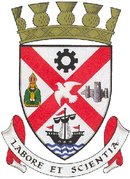Clydebank
|
|
The red saltire on the white field is for the ancient province of Lennox and for the town's more recent historic links to Ireland which previously used the same flag. The cog-wheel symbolises all the local industries and the demi-figure of Saint Patrick refers to Old Kilpatrick, a burgh of barony from 1672, and where the saint is reputed to have been born. A representation of part of the Roman Antonine’s Wall has been included as the Wall and Roman forts at Old Kilpatrick and Greenhill are features common to the burgh and to the villages in the District. The lymphad is for Clyde shipbuilding. The Latin Motto - "By Work and by Knowledge" - was the motto of the burgh of Clydebank. In 1985, a dove of peace was added to the coat of arms. The coat of arms was replaced by that of West Dunbartonshire in 1995.
Clydebank (Bruach Chluaidh in Gaelic) is a town in west central Scotland, lying on the north bank of the river Clyde. The town was created in the late 19th century to house workers for the ship building yards and in 1886 was made a Royal Burgh.
Clydebank is currently the largest town in the 'county' of West Dunbartonshire (officially a Local Authority Area); with a population of around 46,000 it is home to roughly half the county's people.
Although not part of the Local Authority Area of the City of Glasgow, Clydebank is part of the city's conurbation and many neighbouring houses and streets fall within the limits of the 2 counties. The town is part of a single urban area which is commonly known to most people as Greater Glasgow and includes areas that fall within the limits of the following counties: West Dunbartonshire, East Dunbartonshire, North Lanarkshire, Renfrewshire, East Renfrewshire and all of the City Glasgow. While the rest of the county is part of the Argyll and Clyde National Health Service area, Clydebank is part of the Glasgow NHS area. Residents of the town (nicknamed Bankies) usually claim to be Glaswegians and most give their address as Clydebank, Glasgow rather than the technically accurate Clydebank, West Dunbartonshire. A 2003 poll conducted by the Scottish National Party suggested that Clydebank residents were unhappy with the town's status as part of West Dunbartonshire and would prefer the restoration of the town's own council, which was scrapped in the 1994 restructuring of Scottish local government. The poll found a common irritation at the location of the 'county' government in Dumbarton, the second largest town (20,000 population) and a view that despite 11 of the total 22 'county' councillors being elected to represent wards within Clydebank, the town residents were distant from their representatives. Also of concern was that Clydebank will no longer share an MP (Member of Parliament) with Milngavie (a neighbouring town in East Dunbartonshire) but from the next election will be represented in the British Parliament by a single MP for all West Dunbartonshire. The same change may yet take place regarding representation in the Scottish Parliament.
A major employer in the town was John Brown's shipyard, which built several well-known ships, including the Hood, Queen Mary, Queen Elizabeth, and Queen Elizabeth 2. Later it became part of Upper Clyde Shipbuilders, which was the scene of a famous "work-in" in the 1970s.
Clydebank has two semi-professional football teams, Clydebank F.C. and Yoker Athletic F.C.. Both are members of the Scottish Junior Football Association and play in the Central League Division 1. Clydebank FC formerly held status as a senior league club but, while in administration in 2002, the club was purchased by a consotrium and moved to Airdrie and renamed Airdrie United. A new club was formed in 2003 and entered the Central district of Scottish Junior football, the remains of the senior level club rising to Division One of the Scottish Football League, manging to attract around 1700 fans to their ground each fortnight, one-sixth of the capacity of a stadium originally built and funded by Airdrieonians, who went bankrupt, partly as a result; the death of Airdrieonians directly led to the move to displace Clydebank from the League.
The town has a large shopping centre which is uniquely divided in two by the Forth and Clyde canal which runs through the town. There are four high schools in the town, called Clydebank High[1] (http://www.clydebank.w-dunbarton.sch.uk/clydebank/), Saint Andrew's, Saint Columba's and Braidfield High. There are numerous primary schools. The town has many bars and pubs, and three nightclubs.
During World War II Clydebank's production of ships and munitions for the allies made the town a target for the German Luftwaffe: 439 bombers dropped over 1000 bombs on 13th and 14th of March 1941. Of 12,000 homes in the town less than a dozen were undamaged and over 35,000 people were made homeless. The raid, known as the Clydebank Blitz, was the worst suffered by Scotland during the war and resulted in 578 civilian deaths. A memorial exists opposite the Town Hall (as of July 2004 this memorial is a building site, due to it being renovated) to the "Defenders of Clydebank", the officers and sailors of the Polish destroyer Piorun, which was in John Brown's shipyard at the time, and was remembered for the heavy anti-aircraft fire it put up during the raids. Two German bombers were shot down by RAF fighters during the raid, but none were shot down by anti-aircraft fire.
Areas of Clydebank
Antonine Park, Dalmuir, Dalmuir West, Dalnottar, Drumry, Duntocher, Faifley, Hardgate, Linnvale, Mountblow, North Drumry, North Kilbowie, Old Kilpatrick, Parkhall, Radnor Park, South Drumry, and Whitecrook.
References
- I.M.M. MacPhail, The Clydebank Blitz (1974, ISBN 0852790619)

